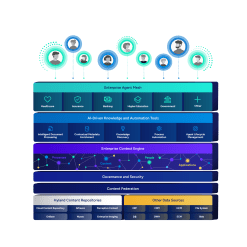DGT
Dirección General de Tráfico (DGT)’s shift to a paperless office has resulted in powerful workflow and automation enhancements, bringing in an estimated annual ROI of 2 million euros.

Harness the power of a unified content, process and application intelligence platform to unlock the value of enterprise content.
Learn more
Automate your document-centric processes with AI-powered document capture, separation, classification, extraction and enrichment.
Learn about Hyland IDPIt's your unique digital evolution … but you don't have to face it alone. We understand the landscape of your industry and the unique needs of the people you serve.
 Overview of industries
Overview of industries
Countless teams and departments have transformed the way they work in accounting, HR, legal and more with Hyland solutions.
 Overview of departments
Overview of departments
We are committed to helping you maximize your technology investment so you can best serve your customers.
 Overview of services
Overview of services

Discover why Hyland is trusted by thousands of organizations worldwide.
Hear from our customers
Our exclusive partner programs combine our strengths with yours to create better experiences through content services.
Overview of partners
Join The Shift newsletter for the latest strategies and expert tips from industry leaders. Discover actionable steps to stay innovative.
Register now
Hyland connects your content and systems so you can forge stronger connections with the people who matter most.
Learn about HylandWith our modern, open and cloud-native platforms, you can build strong connections and keep evolving.
 Dig deeper
Dig deeper
Reading time minutes
Dirección General de Tráfico (DGT)’s shift to a paperless office has resulted in powerful workflow and automation enhancements, bringing in an estimated annual ROI of 2 million euros.

The Dirección General de Tráfico (DGT) is the body in charge of managing vehicle traffic and road safety in Spain. Every year, it processes millions of purchase/ sale registers, new registrations, penalties and other proceedings. Therefore, it offers a high-impact service for individuals, companies and also for other public administrations, collaborating, for example, with law enforcement authorities in the provision of key information for the identification of crimes. In short, the modernization of document management and processing is a permanent challenge for the DGT, especially because of its high impact on citizens.
Before 2015, the DGT’s organizational culture was 100% paper based. Among other issues, it presented significant difficulties in the traceability of its documents, with the resulting cost overruns in both archiving and human management. The path towards a solid institutional digitization strategy involved a radical change in the organization and a major technological challenge, in which Hyland is still involved.
The DGT technical team not only had to convince an entire organization of the benefits of the paperless office, but they also had to plan a successful migration by prioritizing issues such as interoperability, transparency and agile management. They calculated the ROI of this challenge: a saving of more than 2 million euros per year.
The objective was to develop an electronic document management system that would include paper, electronic and hybrid records, integrating the entire lifecycle of these records based on a technical solution with guarantees for the future, using market solutions with a high capacity for customization (avoiding the high cost of ad-hoc solutions) and facilitating the integration of multiple business applications. Flexibility, autonomy, scalability and future projection are the keys to this success story, which is currently evolving with the incorporation of a tool that systematizes the procedures prior to document management.
Up to the current stage of development and focused on the automation of electronic procedures, the DGT solution has been evolving and incorporating new challenges.
In 2015, it took place the definition of the reference framework and implementation of the first system that allowed the DGT to comply with the current legislation on the digitization of documents, the ENI (National Interoperability Scheme). This law requires that the documents issued by the administration have a format with specific metadata assigned to them.
In 2018, the implementation of electronic signatures, the geolocation of records, the development of a multimedia repository and the control of the life cycle of records were addressed.
In 2020, the institution experienced a large increase in the volume of electronic records and an expansion of digitization in general, mainly due to the COVID-19 pandemic.
Currently, DGT and Hyland are working on automating processes through the RPA, optimizing interoperability and developing a new file handler. The processor assigns files to the DGT staff in charge of handling them, which is the equivalent of the counter where the official receives requests from the public and is an ideal complement to document management. All of this using the product’s own work-flow capabilities and resorting to non-relational databases such as Mongo DB.
Before digitization, each employee spent half an hour a day searching for, organizing and sending documents; now they no longer do. In addition, the DGT will save around 800 working hours in the first year with the new processor.
During implementation, millions of data were transferred to more efficient management processes. Currently, the number of files that are processed in physical offices is less than 5-10% of the total.
Using RPA, a complex process involving multiple systems and stakeholders was streamlined into a single process.
Exchange with other public administrations is becoming increasingly sophisticated. The system allows the results of the DGT’s records lifecycle to be dumped into the administration’s general archive.